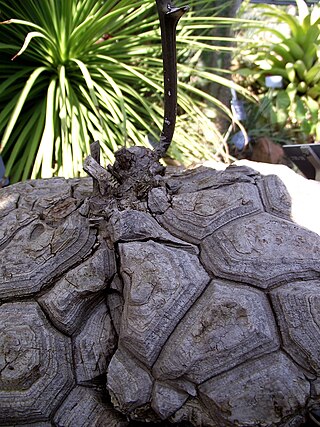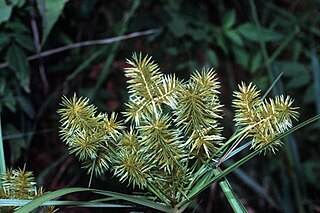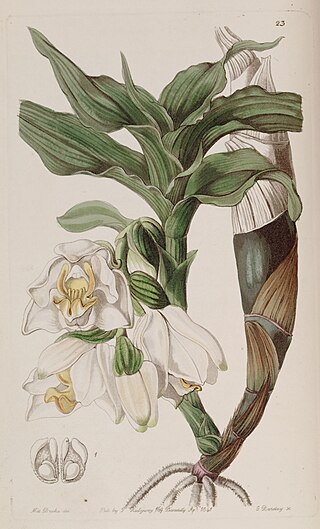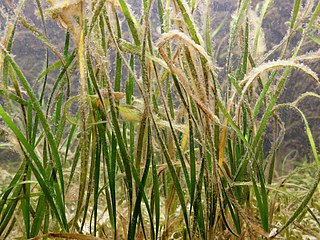
Cyperus is a large genus of about 700 species of sedges, distributed throughout all continents in both tropical and temperate regions.

Calyptrogyne ghiesbreghtiana, commonly called the coligallo palm, is an understory palm native to Central America and southern Mexico, where it grows in tropical rainforests.

Dioscorea mexicana, Mexican yam or cabeza de negro is a species of yam in the genus Dioscorea.

Cameraria is a genus of plants in family Apocynaceae, first described for modern science by Linnaeus in 1753. It is native to southern Mexico, Central America, and the West Indies.

Cyperus acuminatus is a common species of sedge known by several common names, including tapertip flatsedge and pale umbrella-sedge. This plant is native to North America, where it is widespread across the Great Plains and the western United States, with scattered populations in the eastern US as well as in Saskatchewan, Tamaulipas and Coahuila.

Cyperus difformis is a species of sedge known by several common names, including variable flatsedge, smallflower umbrella-sedge and rice sedge. This plant is native to southern Europe, most of Africa and Asia, and Australia, and it is naturalized in other areas of the world, including large parts of the Americas.

Cyperus fuscus is a species of sedge known by the common name brown galingale, or brown flatsedge. This plant is native to much of Europe, Asia and North Africa from England, Portugal and Morocco east to China and Thailand. It is an introduced species in North America, where it is naturalized in widely scattered locations in the United States and Canada.

Cyperus odoratus is a species of sedge known by the common names fragrant flatsedge and rusty flatsedge. This species is quite variable and may in fact be more than one species included under one name.

Cyperus squarrosus is a species of sedge known by several common names, including bearded flatsedge and awned flatsedge. It is found in wet environments in North and South America, Africa, Australia, southern Asia and Italy.
Cyperus parishii is a species of sedge known by the common name Parish's flatsedge. It is native to the southwestern United States and northwestern Mexico. It grows in desert, mountain, and coastal habitat in Sonora, southwestern New Mexico, Arizona, southern Nevada and southern California. It is an annual sedge forming small clumps up to about 25 centimeters tall. The inflorescence is a spherical cluster of up to 30 reddish spikelets with a few long, leaflike bracts at the base.

Cyperus strigosus is a species of sedge known by the common names false nutsedge and straw-colored flatsedge. It is native to the United States, Cuba and Canada, where it grows in wet areas in many habitat types, including disturbed and cultivated areas such as roadsides and crop fields. It is common and sometimes weedy. It is a perennial sedge growing up to 70 centimetres tall. The inflorescence is a cluster of many linear-shaped spikelets up to 3 centimetres long each. A few long, leaf-like bracts grow at the base of the spike.

Chysis bractescens is a species of orchid. It is native to Oaxaca, Tabasco, Guatemala, Belize, El Salvador, Honduras, and Nicaragua.
Billbergia viridiflora is a plant species in the genus Billbergia native to Tabasco, Belize and Guatemala.
Quercus oleoides, with Spanish common names encina or encino, is a Mesoamerican species of oak in the southern live oaks section of the genus Quercus. It grows in dry forests and pastureland of eastern and southern Mexico and much of Central America, from Guanacaste Province in Costa Rica north as far as the State of Tamaulipas in northeastern Mexico.

Halodule wrightii is an aquatic plant in the Cymodoceaceae family. It is referred to by the common names shoal grass or shoalweed, and is a plant species native to seacoasts of some of the warmer oceans of the world.

Yucca lacandonica is a plant species in the yucca genus with the common name "tropical yucca." It is native to Belize and to southern Mexico, the states of Chiapas, Veracruz, Tabasco, Quintana Roo, Campeche, and Yucatán. It is uniquely the only epiphytic species in the genus, although it has been reported to grow terrestrially as well.

Jaltomata procumbens, the creeping false holly, is a plant species native to Arizona, USA, Mexico, Central America, Colombia, Ecuador, and Venezuela. It grows as a weed in agricultural fields and other disturbed locations, but in many places the people protect it because of the edible fruits it produces.
Iresine heterophylla, or Standley's bloodleaf, is a plant species native to the southwestern United States and also to Mexico. It has been collected from Arizona, New Mexico, Texas, Chihuahua, Sonora, Durango, Coahuila, Nuevo León, Campeche and Tabasco.
Diastatea is a genus of plants native to Latin America, mostly in Mexico and Central America but with one species extending southward along the Andes to Argentina.
- Diastatea costaricensisMcVaugh - Guatemala, Honduras, Nicaragua, Costa Rica
- Diastatea expansaMcVaugh - central Mexico
- Diastatea ghiesbreghtii(Kuntze) E.Wimm - southwestern Mexico
- Diastatea micrantha(Kunth) McVaugh - widespread from central Mexico to the Jujuy region of northern Argentina
- Diastatea tenera(A.Gray) McVaugh - southern Mexico and Guatemala
- Diastatea virgataScheidw. - southern Mexico
Cirsium mexicanum is a Mesoamerican and Caribbean species of plants in the tribe Cardueae within the family Asteraceae. Common name is Mexican thistle. It is widespread across Mexico, Central America and the West Indies.














